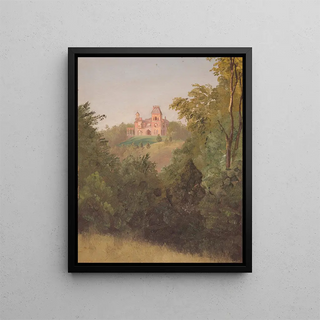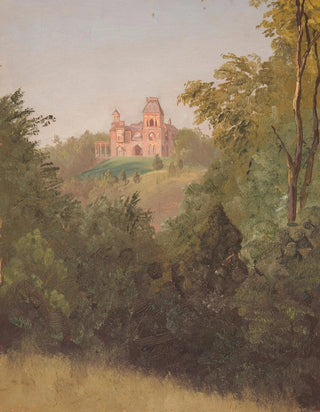Southwest Olana Painting by Frederic Edwin Church | Art print


View from behind

Frame (optional)
"Olana du sud-ouest" is an iconic art print by Frederic Edwin Church, a master of 19th-century American landscape art. This painting, which captures the majesty of natural scenery, takes the viewer on a visual journey through valleys and mountains of an America still wild. The work evokes an atmosphere of serenity and contemplation, inviting reflection on the beauty and grandeur of nature. Church, through his brush, manages to create a dialogue between man and his environment, making this art print timeless and deeply moving. The art print Olana du sud-ouest - Frederic Edwin Church offers a unique opportunity to explore this symbiosis between art and nature.
Style and uniqueness of the work
Frederic Edwin Church's style is characterized by meticulous attention to detail and a vibrant color palette that captures light in an almost magical way. In "Olana du sud-ouest," every brushstroke seems to breathe life, with blazing skies and landscapes of impressive textural richness. The artist uses chiaroscuro techniques to emphasize contrasts between shadows and lights, creating a dramatic atmosphere that draws the eye and stimulates the imagination. Natural elements, such as majestic mountains and lush vegetation, are rendered with precision that reflects Church's attentive observation. His approach to landscape transcends simple representation, evoking a spirituality that invites contemplation and wonder at the beauty of the world.
The artist and his influence
Frederic Edwin Church is one of the leading figures of the Hudson River School movement, which gave rise to an artistic school focused on celebrating American landscapes. Influenced by his travels in South America and the Middle East, Church incorporates exotic elements into his works, enriching the visual vocabulary of landscape art. His bold use of color and light has inspired many contemporary artists and paved the way for later artistic movements. Church firmly believed in the capacity of art to evoke deep emotions and to raise public awareness of the beauty of the

Matte finish

View from behind

Frame (optional)
"Olana du sud-ouest" is an iconic art print by Frederic Edwin Church, a master of 19th-century American landscape art. This painting, which captures the majesty of natural scenery, takes the viewer on a visual journey through valleys and mountains of an America still wild. The work evokes an atmosphere of serenity and contemplation, inviting reflection on the beauty and grandeur of nature. Church, through his brush, manages to create a dialogue between man and his environment, making this art print timeless and deeply moving. The art print Olana du sud-ouest - Frederic Edwin Church offers a unique opportunity to explore this symbiosis between art and nature.
Style and uniqueness of the work
Frederic Edwin Church's style is characterized by meticulous attention to detail and a vibrant color palette that captures light in an almost magical way. In "Olana du sud-ouest," every brushstroke seems to breathe life, with blazing skies and landscapes of impressive textural richness. The artist uses chiaroscuro techniques to emphasize contrasts between shadows and lights, creating a dramatic atmosphere that draws the eye and stimulates the imagination. Natural elements, such as majestic mountains and lush vegetation, are rendered with precision that reflects Church's attentive observation. His approach to landscape transcends simple representation, evoking a spirituality that invites contemplation and wonder at the beauty of the world.
The artist and his influence
Frederic Edwin Church is one of the leading figures of the Hudson River School movement, which gave rise to an artistic school focused on celebrating American landscapes. Influenced by his travels in South America and the Middle East, Church incorporates exotic elements into his works, enriching the visual vocabulary of landscape art. His bold use of color and light has inspired many contemporary artists and paved the way for later artistic movements. Church firmly believed in the capacity of art to evoke deep emotions and to raise public awareness of the beauty of the
12,34 €






